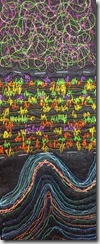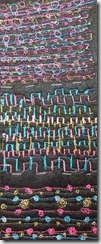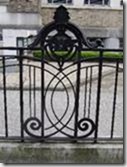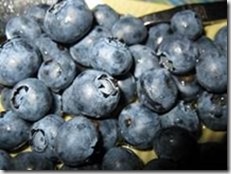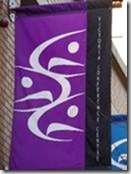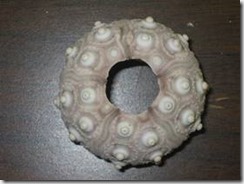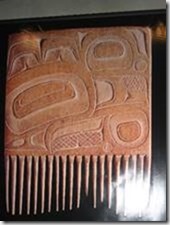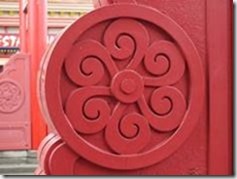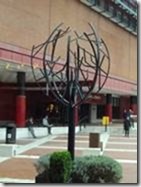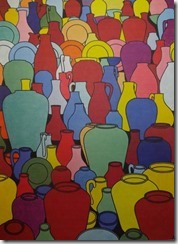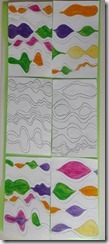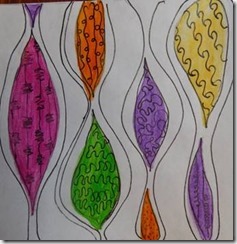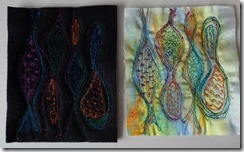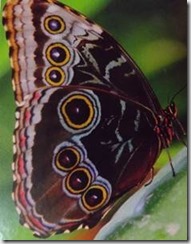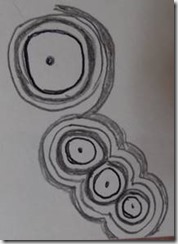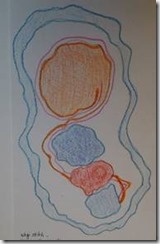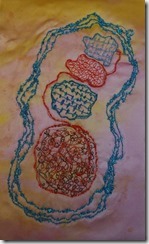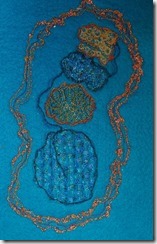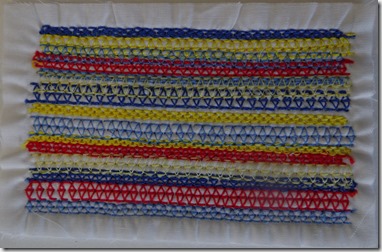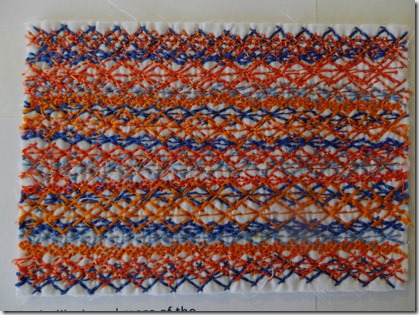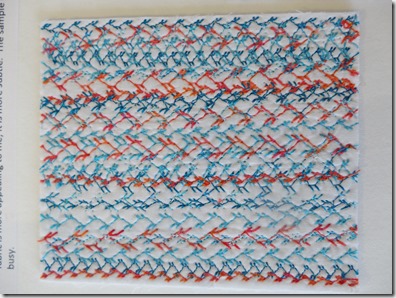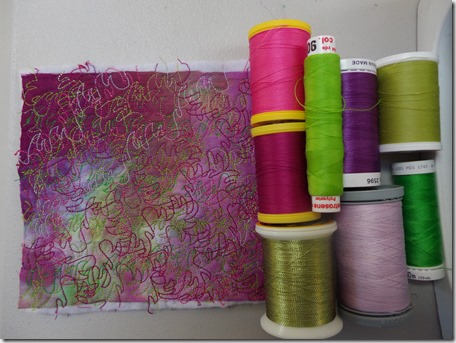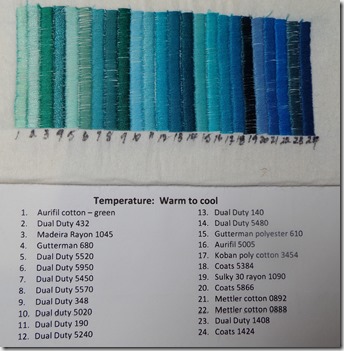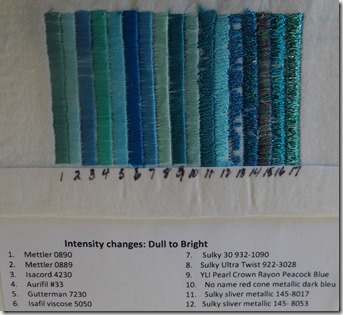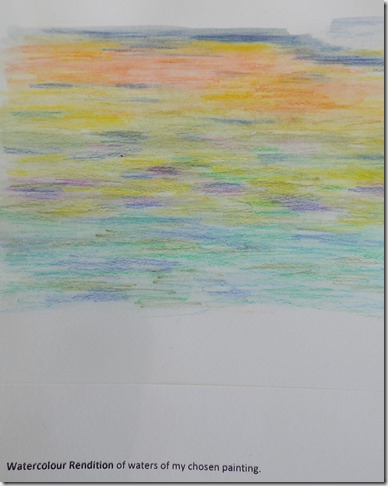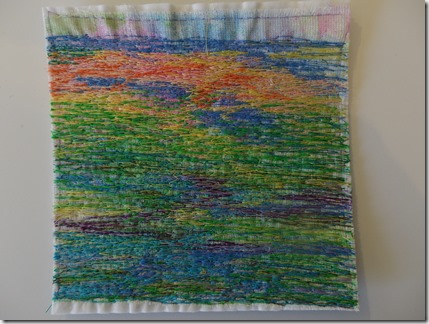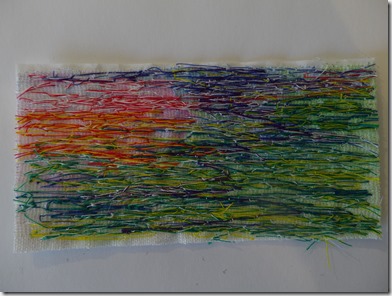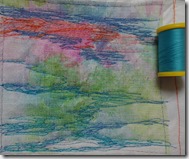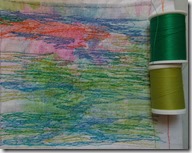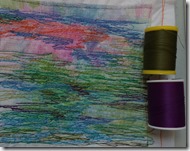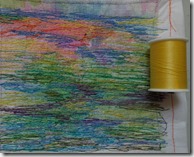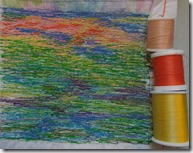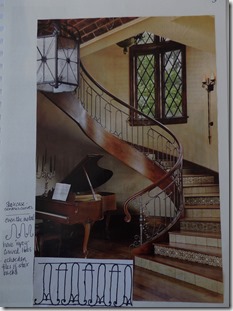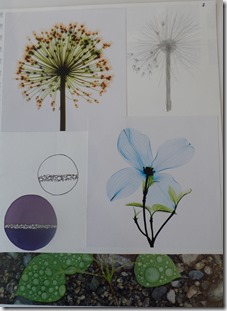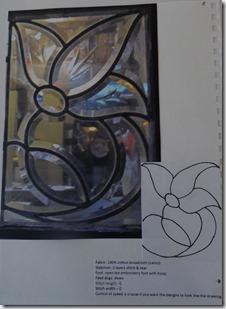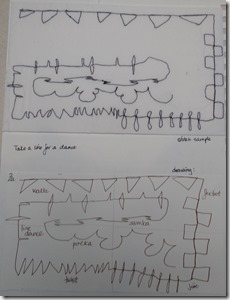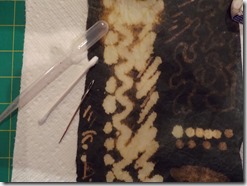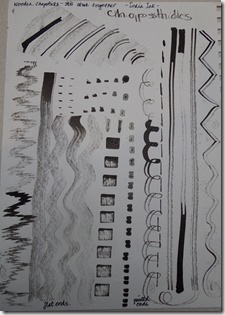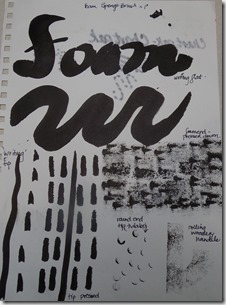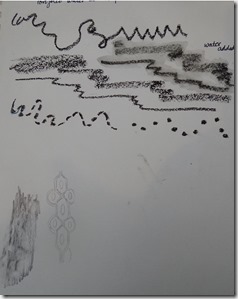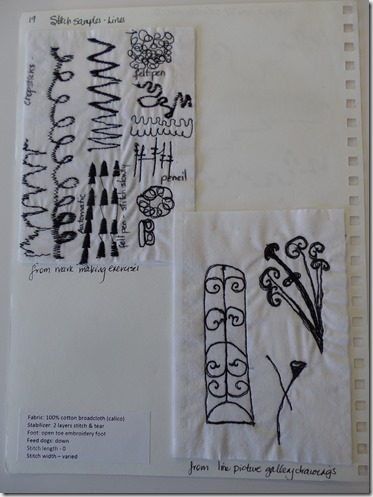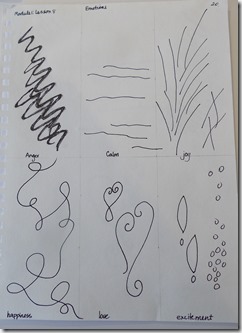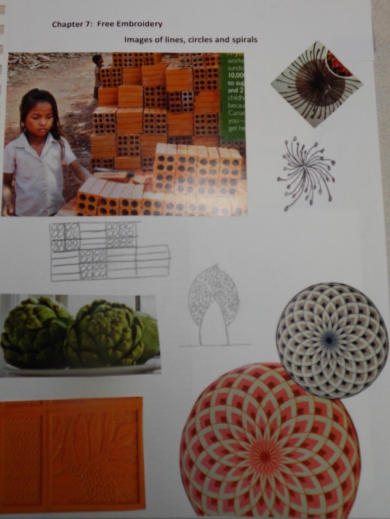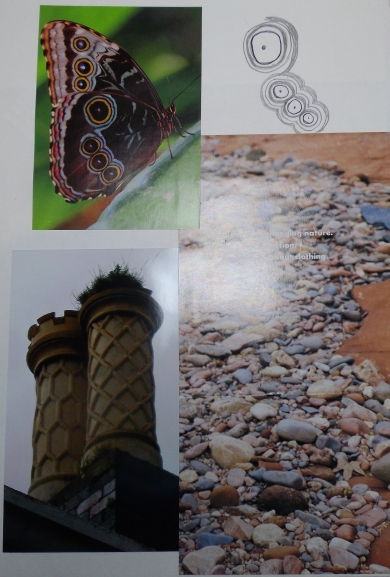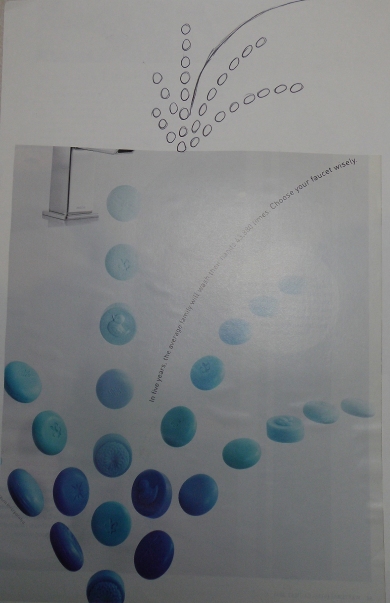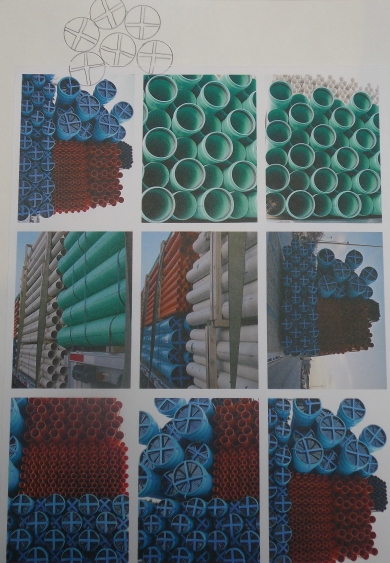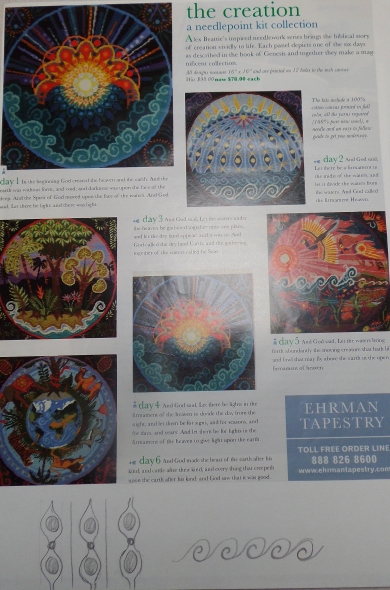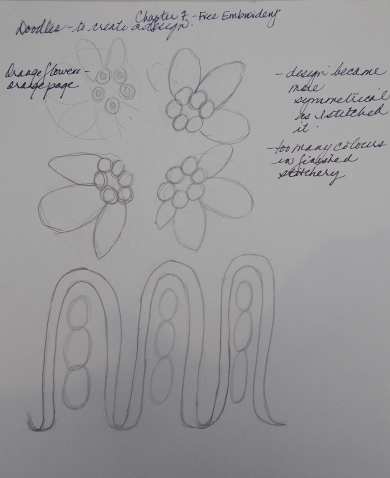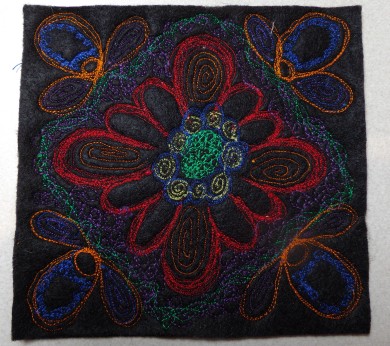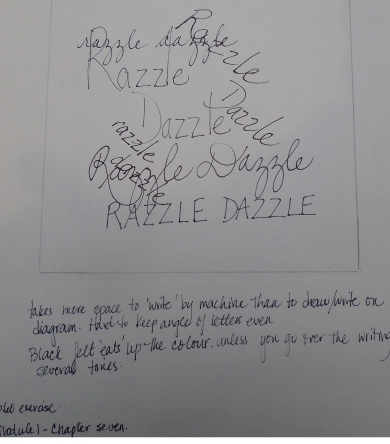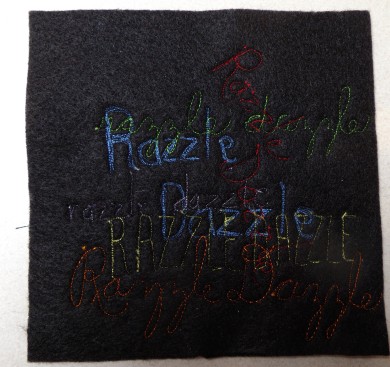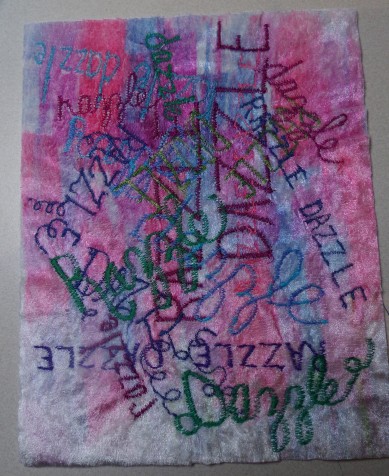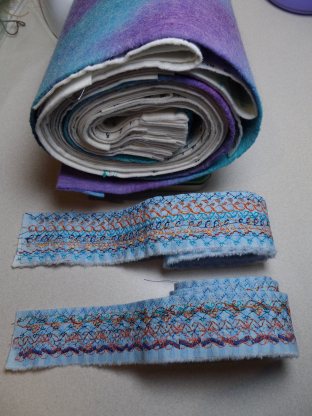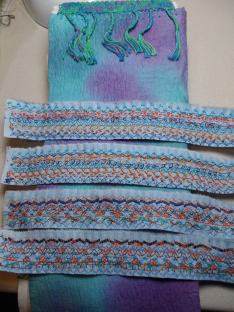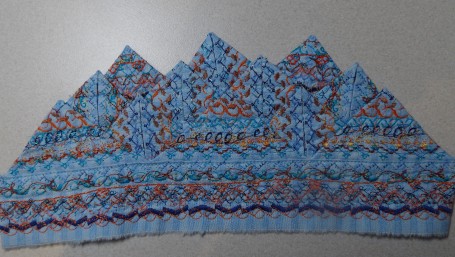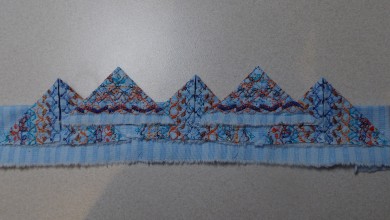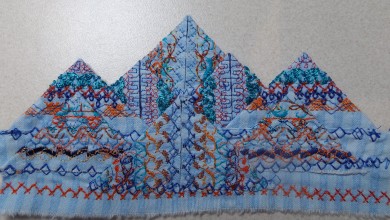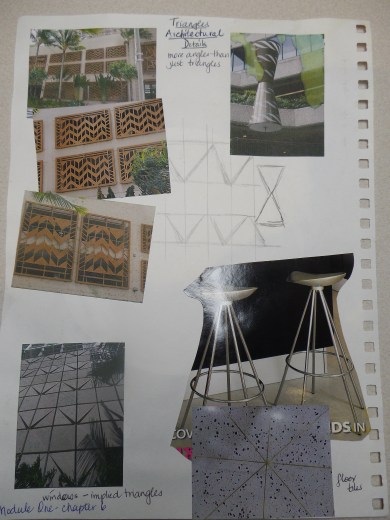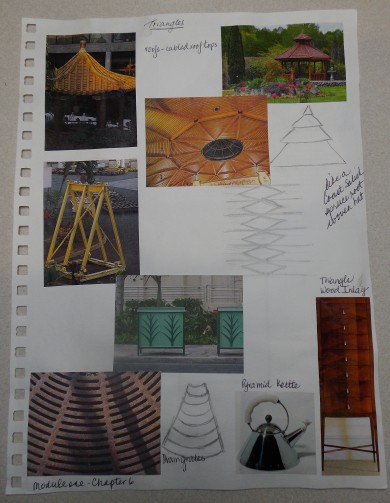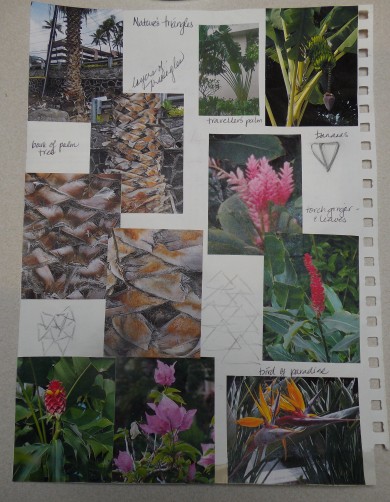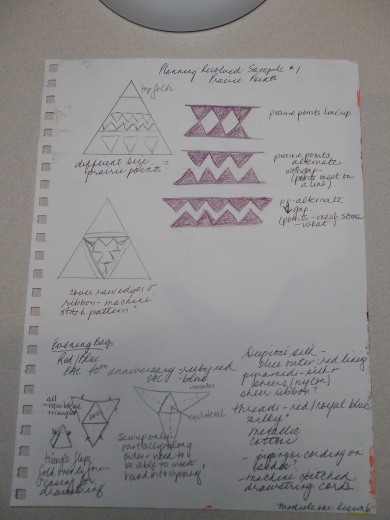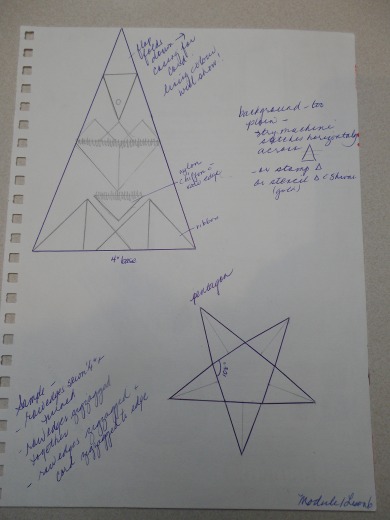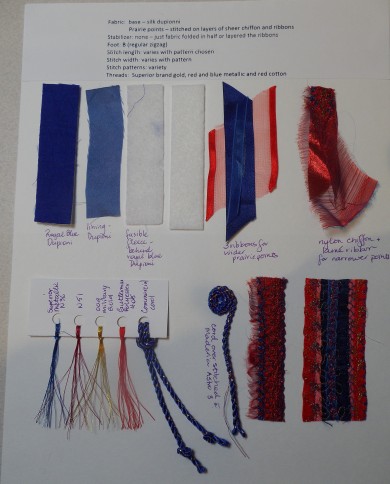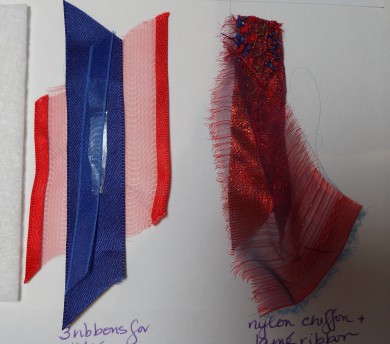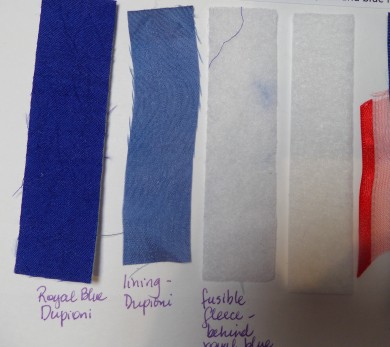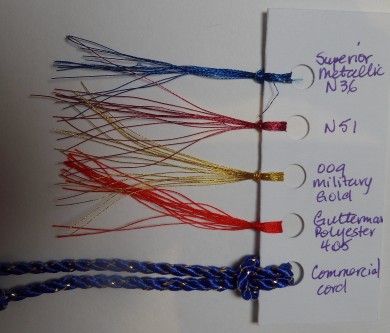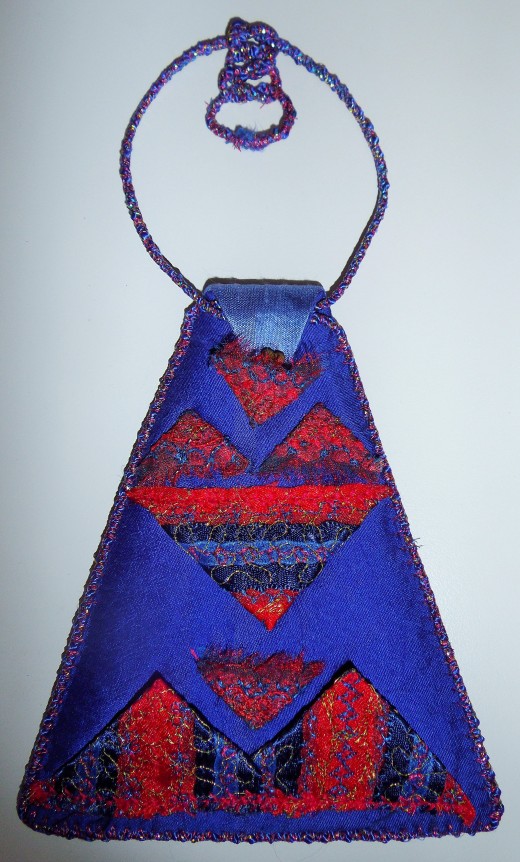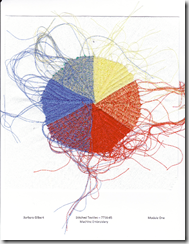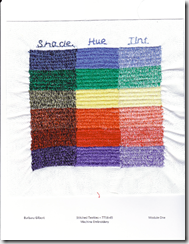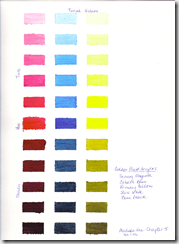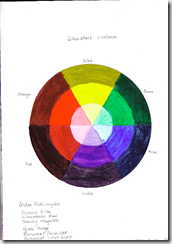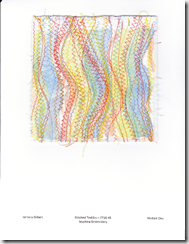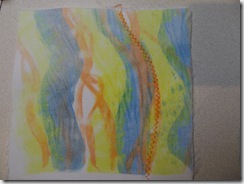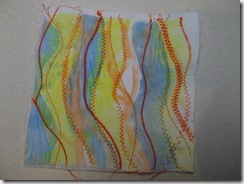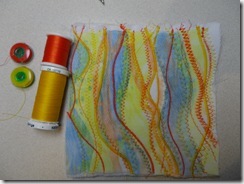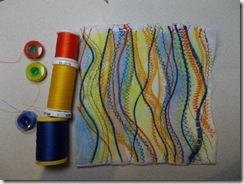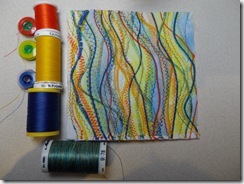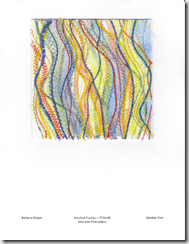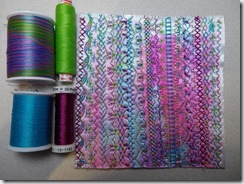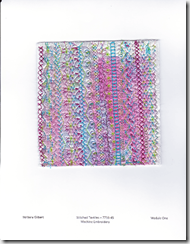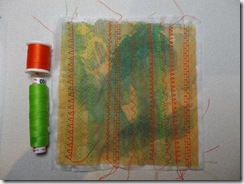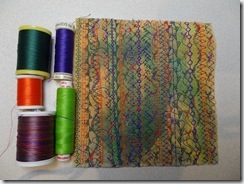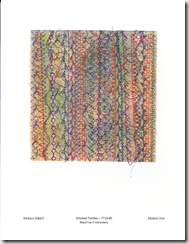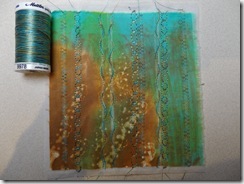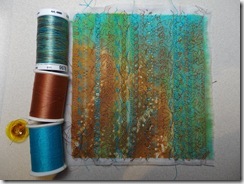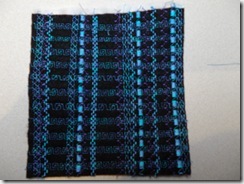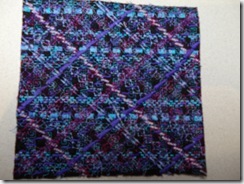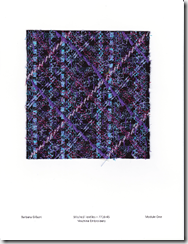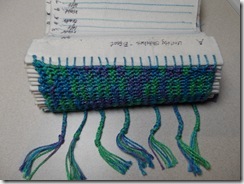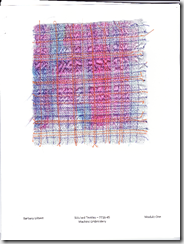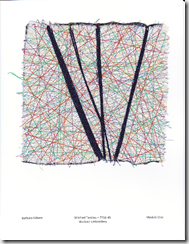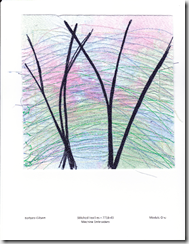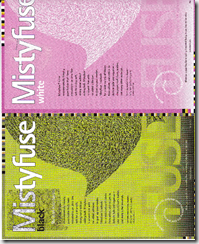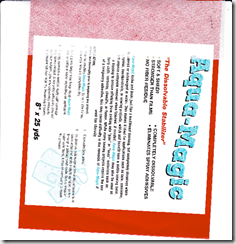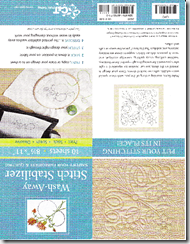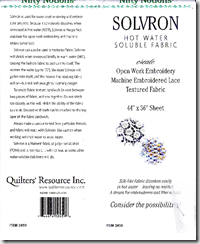Chapter 1: Collecting Colour
1. Colour Search
As I sit in my studio I see one wall of variations of orange, brown, and a cabinet top with a rainbow of colours and my work table topped with green. The rest of the room is a mishmash of colours: books bound in every colour; the pale ash wood of the cupboard doors; the wall of windows with a garden view; the woven baskets, plastic bins and tote boxes filled with fabrics and projects and of course, Chester, the cat, trying to be front and center in the way.
The oranges are from my design board of lilies; they range from intense to pale in an analogous colour harmony: yellow, yellow-orange, to orange to red-orange to red – pink to burgundy. The wall – the background surrounding the design board -is peach, a soft tint of orange; “Winthrop peach” according to the paint colour name! The lily designs on the design board are bold, brighter and stand out against the pastel wall colour. The paper designs have been created from painted papers – blending yellows and reds to create new oranges. The shiny copper sheet – another variation of orange – with the embossed lily design and my coloured pencil drawings of two lilies is a strong contrast to the matt surface of the rest of the board. There are slight lime green accents implying the greenery amongst the lilies.
And beside the massive design board are two very small acrylic paintings done by the aboriginal women near Alice Springs, Australia. They continue the orange them, pale to dark, with added black accents. The orange varies again from red –orange through orange to yellow-orange. And on the adjoining wall is my large Anchor poster of “Embroidery Stitches” with a red-orange background. And, of course, Chester fits right in as he is an orange cat!
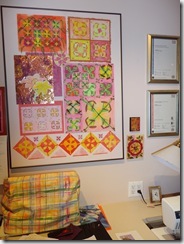

This is my outlook when I am working on my sewing machine or embellisher.
Looking up to the top of my large wooden storage cupboard is the rainbow of button jars. I inherited several button jars from relatives and decided to display the buttons in canning jars. There are 10 jars, each with a different colour of buttons, large and small tumbled together. (The larger jar of pearl buttons is stored elsewhere.) Each jar has its own colour from the lightest pastel tints to intense dark shades of the colour; some shiny buttons glint out from the jars. The jars contrast with the shiny, smooth black surface of the old Singer sewing machine (beside Chester’s basket!). The curtains and machine covers are made from a fabric printed in a rainbow “plaid”. This is to remind me that I need to use all the colours, not just blue! No one colour is more important than the other.
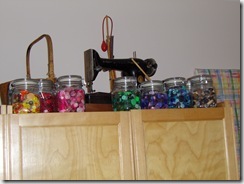
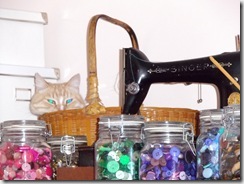
My work table is a wooden structure built by my husband. It is covered in a matte white arborite. However, most days the green Olfa cutting mats are in place and what I see is the green of the mats. It is a medium or mid green, much like grass in the late spring. There is a yellow grid on the surface. In order to do the next exercise with the torn paper pieces, I had to cover the mats with a white board so the green did not interfere with the colours that I was seeing.
The brown in my studio is the woven baskets and the ash wood used to build the cabinets and cupboard door fronts and the table legs. The wood is ash, a very pale yellowy brown colour with slightly darker gain markings. The baskets are various shades of darker brown, filled with yarns and balls of fleece in a rainbow of colours.
I don’t like to live in a space that has white or beige walls. To me, I need colour on my walls to feel at home, warm and comfortable. In fact, my mother-in-law has been known to say about my house “what colour of blue is that room?” My bedroom and two bathrooms are blue and white. I do understand the need for a white space when designing, but I need to live with colour. My husband is red/green “colour challenged” (as he calls it) so sometimes we have interesting discussions! I have had to tell him whereabouts on a wall he finished painting as he cannot see a subtle colour difference between dry paint and wet paint or the under wall colour of beige. This “challenge” was a good check for me when I was doing the tonal value colour exercise as he doesn’t see the colour, just the values.
2. Organizing Colour: Colour pages
When I did this exercise, I decided that – at the same time – I should complete a similar exercise that I was supposed to have finished many years ago. I used my extra cut papers to create a colour wheel in a larger sketch book. (large sketch book on left and sketch book for thison right)
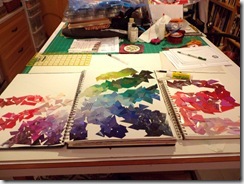
For the colour wheel exercise, I divided the colours up into 12 separate colours and arranged the pieces from dark to light in the center. For this course I divided the colours into only 6. So my green page goes from yellow-green to blue green and I arranged it in value from dark to light. All 6 of my colour pages are arranged in the same manner.
I tend to like the cool colours and tints of colours best. My impressions of the six colour pages are listed below.
Green
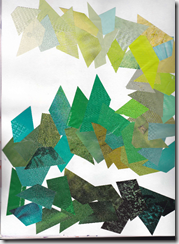
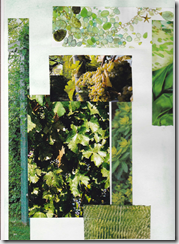
*invokes impressions of nature & freshness – green growth in the spring, coolness of the forest
*tends to be a calm colour for me
*lots of variations of green papers available to use
*not my favourite colour to stitch – always seems so much greenery in a project to stitch and I leave it till the end!
*Christmas
Blue
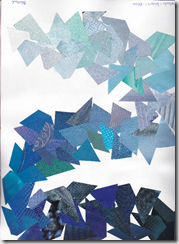
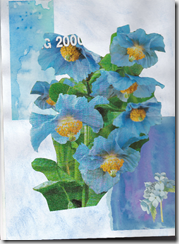
*my favourite colour to wear and live with
*calmness, serenity
*the horizon on water, the sky, the mountains (I was born in the Rocky Mountains)
*winter cold
*lots of blues available, more of the darker tonal values
Violet

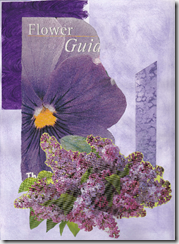
*royalty, mystery, mourning,
*mauve, lavender and lilac – spring like, the colours of my favourite flowers and scents
*Easter (with yellow)
*lots of car ads had blue-violet as their background colour
Red
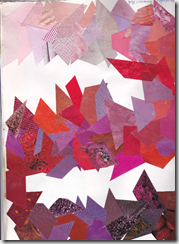
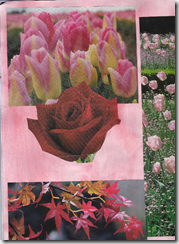
*action – energy, exciting, heat, fire
*I like pinks and burgundy rather than intense red. I have bought red shoes in the past two years – very different for me! A little touch here and there does it for me.
*Christmas
*Valentines, hearts- pink to burgundy
*many of the ads used an intense pure red, so there are more samples from mid tone red
Orange
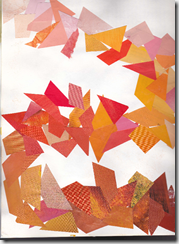
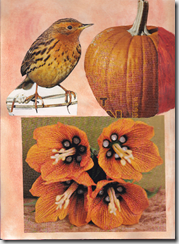
*Halloween – pumpkins, squash
*fire flames, warmth, spicy
*I avoid orange – most oranges do not look good with my skin.
* Again, many ads used intense orange or red-orange and it was hard to distinguish from red, especially if working at night. A fair amount of yellow-orange available. Red-oranges supplemented with painted papers.
Yellow

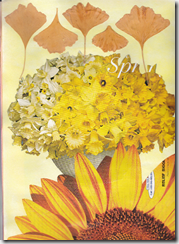
*This is my least favourite colour to wear or work with: it makes me look jaundiced.
*sunshine, moonlight, daffodils, and marigolds – little touches work well.
*autumn leaves
*gold – richness, luxury
*Yellows in the ads often faded or moved to yellowy browns & beiges in ads. Supplemented with some painted papers
3. Collecting Colour.
a. For my colour pages/picture gallery, I chose flowers or greenery to showcase each of the 6 colours. I like to garden, especially flowers in the summer. I added words to how colours make me feel in the organizing section above.
One colour scheme I like to work in is orange and blue, specifically using blue-green and more coppery shades. I have added one page of orange and blue combinations.
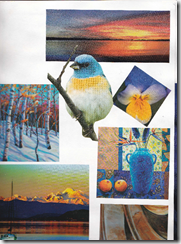

I have other notebooks/sketchbooks of inspirations – collections of trees, sea and sky, flowers, shells, hearts, rocks, circles. I have started to organize my photo files on my computer into design ideas – flowers, pumpkins, lines, etc.
c. Primary colours:
The primary colours- red, yellow and blue – make me think of young children. These colours are often used for children’s toys; they are bright and eye catching and seem to be used in equal amounts. You will also see the 3 primary colours – in their full strength or intensity – used in advertising pictures and labels. I think this is to create an eye catching advertisement.
In collecting pictures of red-yellow- blue, I realize that much of what I have collected is not the pure primaries. It is red-orange, yellow-orange and varying values of blue. I find the complementary combination of blue and orange much more pleasing than the intense primaries. And when does orange become red? Or become yellow?
The primary colours are too intense for me. I prefer to have blue – in any tonal value with just accents of red and even less accent of yellow. Or I like to mix navy blue with pinks. I don’t like to draw attention to myself with bright red or yellow.
Using the primaries in stitch: I would tend to use the red and yellow as accents with blue as the predominate colour. Or I would work from red-violet to violet to blue with perhaps an accent of yellow.

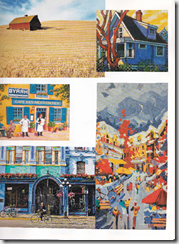
d. I think one of the linking features of the six pictures is the fact that each features curved lines. The objects in the photos are organic, not rigid geometric designs. The colours are bright, not subtle.
Have you read Victoria Findlay’s “Colour – Travels through the Paintbox”? Her book tells the history and origins of the natural colours we use. It is a fascinating read. Right now, I am reading “Mauve” by Simon Garfield. It tells the story of “how one man invented a colour that changed the world” – the work of William Perkin who invented the first aniline dye for mauve. It is a fascinating look at chemistry in the 19th century.
4.Transfer paint
We used two brands of transfer paints from our stash. I have the “Embroidery Adventures” brand that I purchased in the USA and Diana had some G&S Dye transfer paints. I also had a set of the Crayola fabric crayons that is on the sample page. I did not make a whole transfer using these – just this test one.
We made a colour chart of the colours before painting our pages. I ironed mine onto polyester/cotton broadcloth.


The colour chart and sample
Transfer painting is not my favourite way to apply colour. It is a relatively fast and painless way, but the results are unpredictable. I find it difficult to think in reverse by putting the colour I want on top down first. I usually end up with it backwards. And the colours when you paint are so different from the results. I mainly used a foam sponge brush and a paint brush to apply the paint. I found myself making patterns when painting the papers.
The results were certainly more interesting when you over stamped the papers and combined the different patterns.
I liked the results of printing on the bridal satin more so than on the flat surface crepe and even weave fabrics, and found I was using the satin more for the transfers. The bridal satin fabric continued to give good colouring even after using the transfer papers several times.
The two crushed velvet samples I made have great results, but now they are too precious to use!
The polyester/cotton broadcloth gave very pale colours even with the first or second transfer.
I also tried a transfer onto cream coloured acrylic felt. It was one of the transfers I had used several times, but the colour results are interesting.
The photos below show the transfer paper with the sample fabrics I used. I have noted on the back of each transfer paper what fabrics and number of “printings” that I made of each.
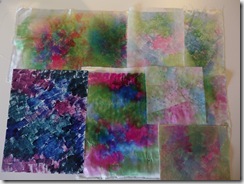

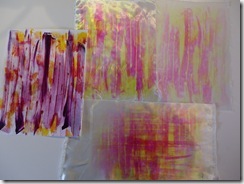
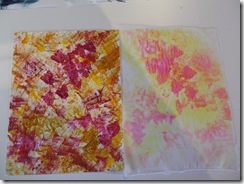
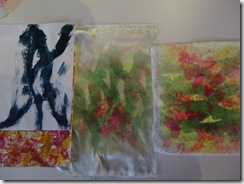
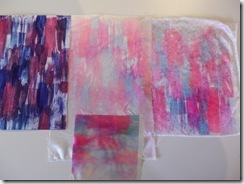
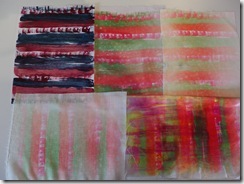

**********************************************************************
I taught fashion studies in high school, so I have included my notes on colour descriptors, colour expressions and emotions or moods of colours from that course.
Colour Notes: Symbolism, Word Associations, Emotions and Phrases
Yellow:
Sunshine – cheerfulness, happiness, optimistic
Warmth, radiance,
Energy, chaos, life force
Wisdom and learning, spiritual enlightenment
Spring freshness, growth – yellow-green is first growth
Autumn leaves – golds and yellow-browns
Lemons, squashes
Cowardice,-treachery, betrayal, greed (avarice), dishonest, egocentric
Jaundiced
School buses
Mellow yellow
Yellow pages (of phone book)
“Yellow with age”
“Yellow peril”
“Yellow bellied”
You are “yellow” – meaning you are chicken – too frightened to do something
Gold
Expensive, luxury, richness
“Good as gold”
“Gold digger”, “gold bricker”
“Golden age”
“Voice of pure gold”
“Golden girl”
Orange
Hottest colour on the colour wheel –
Alert, CAUTION, warning – highly visible colour + safety vests, prisoners’ uniforms
Exuberance, love, happiness
Fire, flames, volcanoes, warmth
Rust – terra cotta- aged
Pumpkins, squashes, peppers, oranges, turmeric, curry powder
Harvest moon
Copper,
Peach
Sunsets
Saffron robes of the Tibetan monks
“Orangeman” (Irish)
“Carrot top” (red head)
“Ginger cat”
“Peachy keen”
“Orange alert” – terrorism alert
Red
Hot, fire, flames, STOP
Energy, exciting, passionate, danger, spicy, joy
Blood, embarrassment – blushes
Red Cross – first aid
Anger, passion, rage
Love, hearts, lust, fertility
Devil, evil
Richness, wealth
Christmas
Accent colour – scarves, lipstick, shoes, red heels
Cardinals’ robes
Chinese culture – bridal robes, good luck
“Seeing red”
“hot Stuff”, “Hot tamale”
“Red light district”
“Blood red”, “red blooded”
“In the red” – losing money
“Red neck”
“Red handed”
“Red herring”
“Red tape” – bureaucracy
“Red party” – communist party– “red square”,” pinko commie”
Politically – Liberal party (NDP in Canada) – red Whigs
“Scarlet letter”, “scarlet woman”
Red hat society – red and purple or pink and mauve
Pink
Sweetness, tenderness, softness
Youthful, feminine
“Tickled pink”
Violet (Purple) – lavender, eggplant, lilac, mauve, plum,
Royalty, regal, dignified, imperial, pomp, pride
Justice, intelligence, knowledge
Richness, expensive
Mystery, cool
Cruel, pompous
Strong, potent, intense, passion
Mourning, grief, sorrow, nostalgia, old age, purple ribbons – memorial wreaths
Christian faith – Advent, Easter
Grapes, wine
Magic – purple cape
Bruises
Purple haze
Flowers – wisteria, iris, lilac, lavender, petunias, pansies, plums and prunes
“Shrinking violet” – shy
“Purple prose”, purple language
“Purple Heart” award for bravery
“Purple with rage”
Red hat society – red and purple or pink and mauve for younger members
Blue
Cold, cool, somber,
Calm, relaxing, serenity, peace, comfortable, secure
Landscape – water, sky, depth,
Sadness, melancholy, depressing,
Indigo – jeans
Navy – uniforms, overcoats, authority
Spirituality, intellect, truth, sincerity,
Safe colour for clothing
Masculine – boy’s colour
Politically – Conservative party in UK and Canada, Republican in USA – blue torries
“Feeling blue”
“Blue blood” – royal/ upper class
“Blue stocking” – intellectual woman
“True blue”
“Blue with cold”
“Blue funk”
“Blue Ribbon” prize – the best!
“Blue moon”
“Blue in the face”
“I’ve got the blues”
Green
Nature, grass, new growth, trees, verdant, lush, re-growth, life and death, hope, eternal life, resurrection,
Spring, fresh, refreshing, youthful
Calm, cool, peaceful
Christmas
Money – “greenbacks”, prosperity
Envy, jealousy
Drab – olive green
Sour (fruit) –
“Green” – not ripe or uncured, unsmoked
“Green wood” – uncured wood
“Greenhorn” – inexperienced, Immaturity
“Green around the gills” -off colour
“Going green” – recycling
Green Peace organization
“Green with envy”
“Green as grass”
“Green room” – theatre term – room offstage
“Green Thumb”
“Grass is always greener on the other side”
White
Purity, angels, innocence, chastity, holiness,
Ghosts, Emptiness, void,
Cleanliness,
Snow, ice cold, clouds, steam,
Virginal, light, air, birth, puberty, confirmation
Bridal wear – western world
“White out”
“Dead White” – no life, flat
“White light” – clarity, enlightenment
“Turn white”, “white as a sheet or ghost”– shock, fright, fainting,
“White knight” – savior, rescue, goodness
“White house” – USA
“White tie affair”
“White hot”
Black
Death, mourning – black armbands, black clothing for widows,
Somber, formal, terminal
Black robes – judges, university robes
Goth
Bohemian, artsy,
Evil, sinister, left, disaster
Bad luck -“black cat”
“Black hole” – empty, void,
”Black Magic” – witches on Halloween
“Black hat – bad guy (good cowboys always wear white hats)
“Black tie” – formal affair, sophisticated, “Little Black dress – LBD” – sexy
“Basic Black” – standard wear
“Black Diamond runs” – difficult ski runs
Feeling “black” – depression
“Blackout” – lack of light
Grey
Neutral, colourless
Mourning
Depression, dreary
Anonymity
Humility, peaceful, secure
Silver
Moonlight
“Silver lining”
“Silver tongue” – glib
“Fast as a silver bullet”
Brown
Earthy
Dependable, realistic
Spiritual death, penitence
Boring
“Brown out” – power/el

